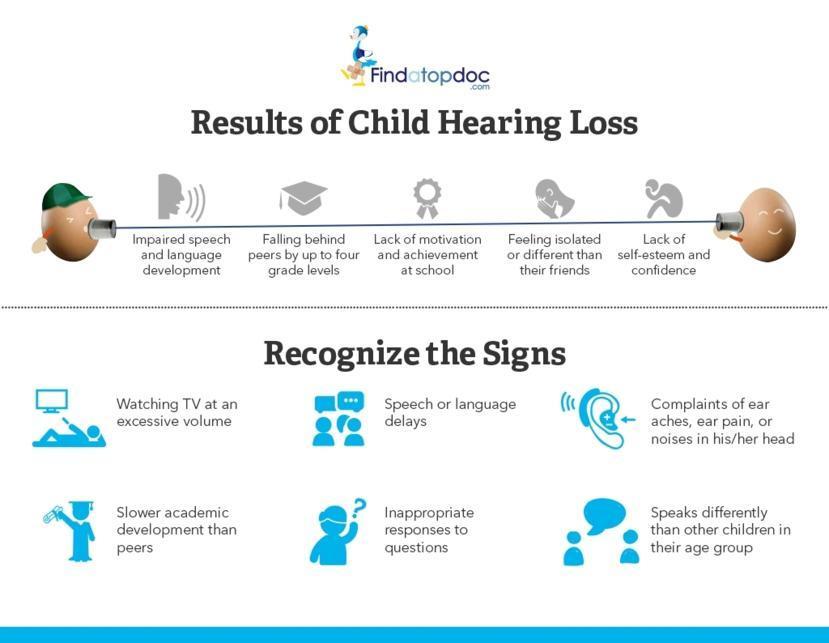The accurate detecting of hearing loss in children can be done with a few hours of birth with current technology. 10 states have mandates that testing of the hearing must be done in the newborn prior to discharge from the hospital. If a loss of hearing is undetected, the child cannot develop normal speech or acquire the cognitive abilities (knowing, thinking, and judging) needed for learning.
Many people think that hearing is graded as normal or deaf and that the child’s hearing is normal if he/she responds to sound and voices, but hearing loss can range from a mild impairment to profound loss.
Common indications for an assessment of hearing in the child is:
- Speech delay
- A family history of hearing loss (can be inherited)
- Frequent or recurrent ear infections
- Infectious diseases that cause hearing loss (meningitis, measles, etc.)
- Syndromes knew to be associated with hearing loss (Down syndrome, the Alport syndrome, and Crouzon syndrome)
Also, when a child is born, they must have hearing assessment if he/she was:
- Assisted ventilation
- Low birth weight (less than 2 pounds) or prematurely
- Low Apgar score
- Hydrocephalus
- Severe jaundice after birth
- Maternal illness during pregnancy (rubella)
An audiologist is a specialist who tests a person’s hearing, but not all audiologists are specialists for testing hearing in children because it requires specific equipment, setup, and training.
- Young children ages 5 months to 2 and half years are tested using a method called visual reinforcement audiometry (VRA). For this test to be accurate, the child must participate and needs to be cooperative and alert. During testing, the child sits on a caregiver’s lap in the center of a room and speakers are situated to the child's right and left side (sometimes small earphones can be used also). The audiologist has a toy and when the child turns his/her head toward the side from which the sound is presented, an audiologist shows a toy to the child to encourage the child to continue participating in the task.
- Children 3-5 years of age can be tested using a method called audiometry. During this test, a child is taught to hold a peg next to his/her cheek and when the child hears the sound, the child places the peg on a Peg-Board.
For children who are unable to cooperate for hearing evaluations (because of their age or to a developmental delay – for example, a child with severe mental retardation) there are two different types of tests.
The first is the frequency-specific auditory brainstem response (ABR) evaluation and it measures of the brainstem's response to sound. On the child’s head are placed four to five electrodes and the sound is presented to the child through small earphones.
As the hearing nerve fires, the sound stimulus travels up to the brain and the electrical activity generated by the nerve can be recorded by the electrodes and presented as waveforms on a computer screen.
During the test, a child must be quiet and still and any muscle movement, including something as small as an eye blink, can obliterate the hearing response so the infant or child must be sleeping during the test (infants less than 3 months during natural sleep and older children can be sedated with mostly oral sedative chloral hydrate).
The second type of test is the otoacoustic emission (OAE) test and it measures an acoustic response produced by the inner ear (cochlea). It is performed by placing a small probe that contains a microphone and speaker into the child's ear.
Sounds are generated in the probe and responses that come back from the cochlea are recorded, and once the cochlea processes the sound, an electrical stimulus is sent to the brainstem.
In addition, there is a second and separate sound that does not travel up the nerve but comes back out into the child's ear canal and this is called the otoacoustic emission. The emission is then recorded with the microphone probe and represented pictorially on a computer screen.
The most common site for ear infections in children is the middle ear and it is the space behind the eardrum. Abnormalities of the eardrum or middle ear can be measured with a tympanogram. First, a probe is inserted in the ear and it creates a vacuum-tight seal. The air pressure is changed in the ear canal from positive to negative, and the movement of the eardrum is recorded.







